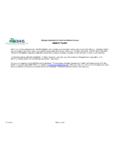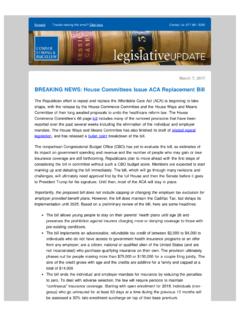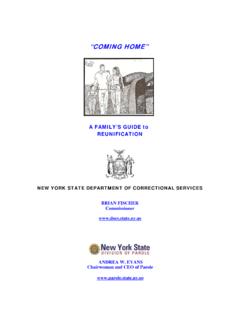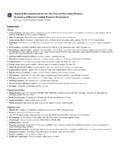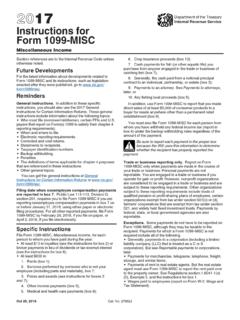Transcription of SEE 1. Sample Test Questions - Internal Revenue Service
1 SEE 1 1 SEE 1. Sample Test Questions 1. Two taxpayers married on November 30. That same year, the husband enrolled in an accredited college to further his career and subsequently received a Form 1098-T, Tuition Statement. The wife was employed with an income of $45,000 and paid for the husband's education expenses. Based on their circumstances, what is the correct method to report the education credit? (A) Taxpayers must file a joint return to claim an education credit (B) Based on the wife s AGI, they do not qualify to claim an education credit (C) Husband is ineligible to claim an education credit because the wife paid his education expenses (D) Wife should report nonqualified education expenses on Form 8863, Education Credits (American Opportunity and Lifetime Learning Credits) Key: A References: IRC 25A(g)(6); Instructions for Form 8863; page 2 2.
2 The taxpayer has a child under the age of 24 who is a full-time student in their 2nd year of college. The student will be claimed as a dependent on the taxpayer s return. The student s educational expenses included $8,000 for tuition and room and board of $4,000. The student received a $5,000 scholarship for tuition use only, as well as an additional $2,500 scholarship to pay any of the student s college expenses. Which of the following statements is correct, based on the information above? Terminology KEY for SEE Sample Test Questions Abbreviation/Term/Symbol: Refers to: IRC or Code Section Internal Revenue Code Instructions IRS Form Instructions Form IRS Tax Form Pub or Publication IRS Publication IRB Internal Revenue Bulletin 31 Title 31 of United States Code Code of Federal Regulations Treas.
3 Reg. or Regulations Treasury Regulations DOL Department of Labor Cir. 230 Treasury Department Circular 230 IRM Internal Revenue Manual Memo Tax Court Memo Symbol for Code Section Numbers and/or letters following the code section symbol are used to guide the user to the appropriate area in the Code for that reference. SEE 1 2 (A) The student can claim the American Opportunity credit on their return for tuition expenses of $2,500 and should report as income $2,000 of the $2,500 scholarship (B) The taxpayer can claim the American Opportunity credit on their return for tuition expenses of $2,500, and the student should report as income $2,000 of the $2,500 scholarship (C) The taxpayer can claim the American Opportunity credit on their return for tuition expenses of $2,500, and the student should not report any of the $2,500 scholarship as income (D) The taxpayer can claim the American Opportunity credit on their return for tuition expenses of $2,500 and should report as income $2,000 of the $2,500 scholarship Key: B References: IRC 25A(i); IRC 117; Publication 970, pp.
4 5, 7 3. Which of the following statements is correct regarding Form 1095A, Health Insurance Marketplace Statement? (A) Taxpayers do not need Form 1095A to complete Form 8962, Premium Tax Credit, to reconcile advance payments of the premium tax credit or claim the premium tax credit on their tax return (B) Taxpayers will receive Form 1095A to complete Form 8962, Premium Tax Credit, if they have been covered by an employer insurance plan for the entire year (C) Taxpayers will use Form 1095A to complete Form 8962, Premium Tax Credit, to reconcile advance payments of the premium tax credit or claim the premium tax credit on their tax return (D) Taxpayers will attach a Form 1095A with their return to reconcile advance payments of the premium tax credit or claim the premium tax credit on their tax return Key: C References: Form 8962 Instructions, p.
5 2 4. To avoid the penalty for not having insurance, taxpayers must be enrolled in qualifying health coverage, also called minimum essential coverage. All of the following are examples of minimum essential coverage EXCEPT: (A) Certain insurance coverage that may provide limited benefits. That includes, but is not limited to, the following types of plans: stand-alone dental and vision, accident or disability income or workers compensation (B) Employer-sponsored coverage. That includes, but is not limited to, the following types of plans: a self-insured group health plan for employees, retiree and COBRA coverage (C) Individual health coverage. That includes, but is not limited to, the following types of plans: health insurance purchased directly from an insurance company, or Health Insurance Marketplace (D) Coverage under government-sponsored programs.
6 That includes, but is not limited to, the following types of plans: Medicare Part A coverage, Medicare Advantage Plans and most Medicaid coverage Key: A References: Publication 974, p. 8 5. Which of the following situations will disqualify a single individual from claiming the premium tax credit? SEE 1 3 (A) Marriage to an individual enrolled in a qualified health plan (B) Increase in household income to 390% of the federal poverty line (C) Inheritance of $1,100,000 non-income producing vacation home (D) Becoming eligible as a dependent on their parent's joint tax return Key: D References: IRC 36B(c)(1)(C); Publication Title: 17, Chapter 37, Premium Tax Credit, Pgs. 246-247; Pub 974; Instructions for Form 8962 6. All of the following income types are reported on Form 1099-MISC EXCEPT: (A) Non-employee compensation over $600 (B) Payments made to a physician or supplier or provider of medical or healthcare services of $600 or more made in the course of your trade of business (C) Canceled debt payments of $600 of more (D) Crop insurance proceeds of $600 or more Key: C References: 2018 Instructions for Form 1099-MISC, pp.
7 6-9; Treas. Reg. 7. What is the total amount a sole proprietor is obligated to report on 1099-MISC forms based on the following expenses claimed on schedule C? Incorporated law firm: $600 Sign printer: $800 ($600 labor and $200 materials) Web page designer: $500 Incorporated janitorial company: $800 Consultant A: $1,000 ($400 paid in cash and $600 paid by check) Consultant B: $500 paid in cash Consultant C: $400 paid by check (A) $1,400 (B) $1,600 (C) $2,000 (D) $2,400 Key: D References: 2018 Instructions for Form 1099-MISC, page 2 states that attorneys fees of $600 or more are reportable in 1099-MISC and page 8 states that services by nonemployee includes parts and materials. Pub 15-A, pp. 8-10 covers whether someone is an employee or a nonemployee independent contractor.
8 SEE 1 4 8. A taxpayer who receives a Form 1099-MISC with the wrong dollar amount in box 7 should do which of the following? (A) Contact IRS for a corrected Form 1099-MISC (B) Contact the payer for a corrected Form 1099-MISC (C) Report the incorrect amount stated on the Form 1099-MISC as income (D) Disregard the Form 1099-MISC since it is incorrect Key: B References: Instructions for Recipient on Form 1099-MISC (2018) 9. A 62-year-old, married taxpayer files Married Filing Separately, and lives apart from the spouse for an entire taxable year. What is the taxpayer s base amount for computing taxable Social Security benefits? (A) Zero (B) $25,000 (C) $32,000 (D) $9,000 Key: B References: 86(c)(1); IRS, Publication 915; page 3 10. To find out if a taxpayer's Social Security benefits may be taxable, all of the following are taken into account EXCEPT: (A) Interest that is tax-exempt (B) The exclusion for foreign earned income (C) Notary fees received (D) Unemployment benefits Key: B References: 86(b)(2); IRS, Publication 17, 11.
9 Which of the following statements is correct regarding repayment of Social Security benefits received in a prior year if the total figure shown in box 5 for all of your current year Forms SSA-1099 and RRB-1099 is a negative amount and the portion of the negative amount that represents benefits you included in gross income in the prior year is $3,000 or less? (A) The taxpayer must amend the prior year return to claim a deduction on Schedule A (Form 1040), and it is not subject to the 2%-of-adjusted-gross-income limit that applies to certain miscellaneous itemized deductions (B) The taxpayer must amend the prior year return to claim a deduction on Schedule A (Form 1040), and it is subject to the 2%-of-adjusted-gross-income limit that applies to certain miscellaneous itemized deductions SEE 1 5 (C) The taxpayer can claim a deduction on Schedule A (Form 1040) for the portion of the negative amount that represents benefits you included in gross income in the prior year, and it is not subject to the 2%-of-adjusted-gross-income limit that applies to certain miscellaneous itemized deductions (D)
10 The taxpayer can claim a deduction on Schedule A (Form 1040) for the portion of the negative amount that represents benefits you included in gross income in the prior year, and it is subject to the 2%-of-adjusted-gross-income limit that applies to certain miscellaneous itemized deductions Key: D References: Publication 17, pp. 85, 88, 92 12. The Affordable Care Act requires individuals to have qualifying health coverage, qualify for a coverage exemption, or make an individual responsibility payment when they file their tax return. All of the following are exempt from the individual shared responsibility payment EXCEPT: (A) A US citizen physically present in a foreign country for at least 330 full days during a period of 12 consecutive months (B) A US citizen who owns a home valued at $1,500,000 but gross income falls below the return filing threshold (C) A US citizen who is currently incarcerated (D) A US citizen, single parent, filing Head of Household with two children and gross income of $125,000 Key: D References: IRC 5000A(d); Instructions for Form 8965 13.










